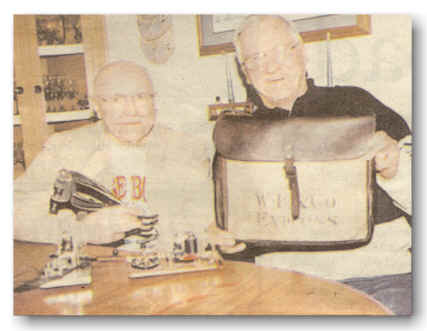|
Home
|
This article about two retired railroad employees appeared in the April 20-26, 2003 Luxemburg News and is reproduced with their permission. (The material inside square brackets [] was supplied by the editor of the Luxemburg News, and did not appear in the print edition.)
Railroad Revisited
Retired men loved workin' on the railroad
By Jim Marcks, Kewaunee Enterprise
The love for trains lives on for two retired Kewaunee men.
|
|
Thorval Franson and Jim Roubal are coffee drinking buddies who not only talking about the good old days, but spend time looking for things to add to their considerable railroad memorabilia collections.
Their collections include such items as a 1934 Union Pacific Passenger Lionel train and American Flyer trains, old railroad lanterns, switch lamps, numerous keys and padlocks, an 1888 passenger schedule and other timetables, advertising and signs. There's even a wooden bucket that was used to take water from the rain barrel in case of a fire.
Thorval Franson, 81, started with the Green Bay and Western Railroad in 1946 at Winona, Minn. He worked at Alma Center and filled in as needed as a relief manager. He also worked as an agent at New London, Kewaunee and completed in career in Green Bay in 1984.
Roubal, whose dad was a conductor, began his career as a brakeman in 1942. He was promoted to conductor at the Ahnapee and Western Railroad in 1947, and ended up being the last agent for the railroad. After locomotives and other equipment were sold, he continued with a manager's agreement for train service by Green Bay and Western Railroad until service was abandoned in 1984.
The two men naturally developed their philosophies based on life on the rails.
Franson said, "Seeing the light at the end of the tunnel may not be a good thing. For a railroad person, it could mean another train is coming."
Roubal joked that the caboose was "the brains of the train." He recalled the caboose had a desk/bunk, a pot-bellied stove and a table for playing cards during layovers while the cars were being unloaded.
Franson, who showed a pail full of markers dated from 1931 to 1954, said that railroad technology changed dramatically over the years. One of his early jobs was placing the train orders and messages on the end of a bamboo pole and handing it to the engineer and conductor. The engineer would untie the message and drop the pole a quarter-mile down the track for Thorval to retrieve.
The telegrapher used Morse Code to communicate with the engineers, a skill not needed today. "We needed poles and copper wire to send the messages," Franson said.
Roubal often was on the railroad's route been Chicago and Door County. In the 1940s, trains transported not only passengers, but livestock, corn, soybeans, Door County cherries, milk, sugar beets, lumber materials, paper and coal.
Roubal remembers the train carrying migrant workers who descended on Door County in summer to help harvest cherries from the 200 orchards. During World War II, even German prisoners of war came to Sturgeon Bay by rail to help harvest the cherries.
Bags of sugar were brought on the train to the cherry canning factories, and there were always a couple of broken bags of sugar left in the car. [Today, there are about 40 cherry orchards and pick-your-own cherries are popular, while processors freeze the cherries and tins.]
According to Roubal and Franson, bad days for the railroad were when rain would wash out a railroad bed, or when snow and ice piled up on the tracks, causing the car to jump off the track.
It was also bad when a herd of cows would cross the tracks. Franson said a farmer once asked the railroad to have his engineer drink an extra cup of coffee before he began his trip, so the farmer would have an extra 15 minutes to drive his cows across the tracks.
